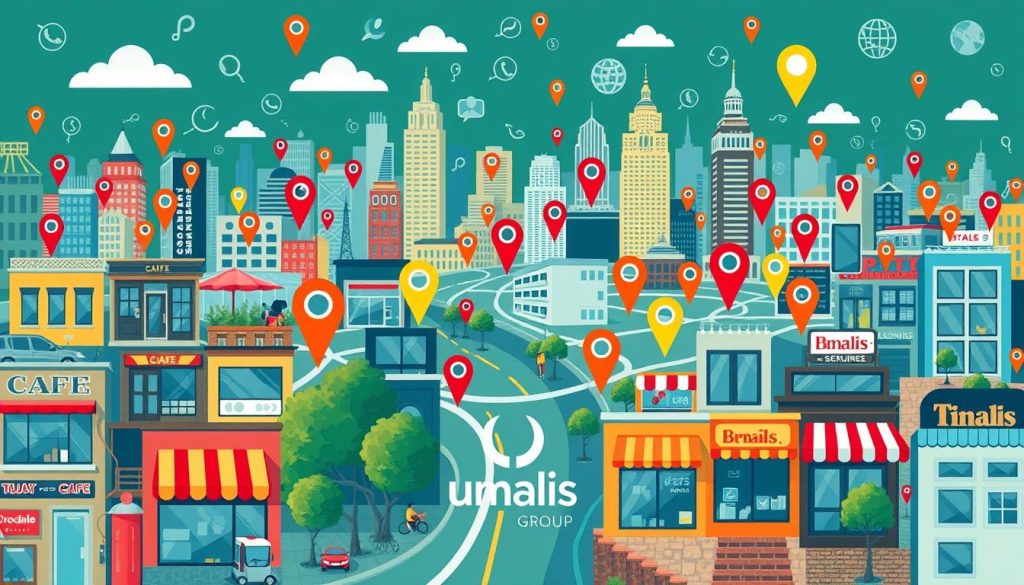In today’s digital age, where consumers spend more time online than they do sleeping, having a strong online presence is crucial for businesses, regardless of industry. As a passionate marketer, I’ve witnessed firsthand the transformative power of digital marketing in helping brands thrive and connect with their target audience. The statistics speak for themselves: 97% of consumers search online for local products and services, and 83% visit a store based on the information they find online.
Your online presence extends far beyond just existing in the digital landscape. It’s about visibility, credibility, and reputation – the very foundation that shapes how potential customers perceive and engage with your brand. By developing an effective online presence, you can unlock a world of opportunities, from getting discovered by new audiences to building trust, marketing 24/7, and optimizing the buyer journey.
Table of Contents
Key Takeaways
- Online presence is critical for businesses, with 97% of consumers searching online for local products and services.
- A strong online presence goes beyond just existing online, it’s about visibility, credibility, and reputation in the digital landscape.
- Developing an effective online presence can help businesses get discovered, be seen as legitimate, market 24/7, and optimize the buyer journey.
- Digital marketing strategies, such as SEO, content marketing, and social media, are essential for building a robust online presence.
- Consistent content creation and a mobile-friendly website can significantly improve online visibility and lead generation.
What is Online Presence and Why it Matters
In the digital age, an online presence is more than just a website – it’s a comprehensive reflection of a business’s digital footprint. Online presence encompasses a company’s visibility, reputation, and engagement across various online channels, from search engines and social media to directories and review platforms. A strong online presence is essential for businesses to thrive in today’s competitive landscape.
Defining Online Presence
Online presence is a deeper layer that paints the full picture of a business, encompassing the actions taken, the content produced, the business’s standing in search engine and social media algorithms, and how the public perceives the business online. A well-crafted online presence helps potential customers discover the business, view it as legitimate, and engage with the brand on a personal level.
Benefits of a Strong Online Presence
A robust online presence offers numerous benefits for businesses, including:
- Improved brand visibility and recognition
- Increased digital marketing benefits, such as higher search engine rankings and more effective targeted advertising
- Enhanced customer trust and credibility through a professional, user-friendly website and active social media channels
- Expanded reach and accessibility to potential customers 24/7
- Opportunities for cost-effective marketing and lead generation
- Valuable data and insights to optimize the buyer’s journey and drive more conversions
Overall, a strong online presence is crucial for businesses to succeed in the digital landscape and stay ahead of the competition. By consistently managing and enhancing their digital footprint, companies can effectively attract, engage, and retain customers in today’s tech-driven world.
“A professional, user-friendly website is essential to boost a brand’s digital presence. Social media presence helps in staying relevant and connecting on a personal level.”
Optimizing Your Website for Digital Marketing
https://www.youtube.com/watch?v=q0phM6a3bVs
In the digital age, a business’s website is often the first point of contact with potential customers. That’s why it’s essential to have a modern, attractive, and user-friendly website. After all, 75% of consumers have admitted to judging a company’s credibility based on the website design. But website optimization goes beyond just aesthetics; it also involves implementing effective search engine optimization (SEO) strategies to improve the site’s visibility in search engine results.
Building a Modern and Attractive Site
To create a website that captivates and engages your audience, focus on the following elements:
- Responsive design that adapts seamlessly to mobile devices, as over 50% of all internet traffic comes from mobile
- Intuitive navigation and clear calls-to-action to guide visitors through the site
- Visually appealing and high-quality imagery that complements your brand
- Fast loading times, as 70% more time is spent on a website if it loads in 5 seconds rather than 19 seconds
Implementing Effective SEO Strategies
Alongside a visually appealing website, search engine optimization (SEO) is crucial for improving your online visibility and attracting more qualified leads. Some key SEO strategies to implement include:
- Creating high-quality, keyword-targeted content to rank for relevant search queries
- Optimizing images with alt text to enhance accessibility and search rankings
- Building a strong internal linking structure to boost page authority and domain authority
- Leveraging rich snippets, marked up with schema.org, to increase click-through rates
- Prioritizing local SEO to reach customers in your geographic area
- Ensuring a mobile-friendly website, as Google uses a mobile-first index to rank sites
By combining a visually appealing website with effective search engine optimization (SEO) strategies, you can enhance your online presence and attract more qualified leads to your business.
Leveraging Blogging for Online Visibility
In the digital age, a business blog can be a powerful tool for improving online visibility and presence. Each blog post can be individually to rank for specific keywords, allowing the business to appear in search results for a wide range of queries that potential customers are searching for. In fact, businesses that publish blogs four times a week get 3.5x more traffic and 4.5x more leads than businesses that only blog once a week.
When business blogging for online presence, it’s important to target one keyword (or keyword theme) per post, use the keyword in the title and headings, optimize images, and promote the content on social media and through email. This strategic approach not only enhances SEO but also helps to generate leads and build brand awareness.
“Blogs and articles can amplify their reach by being shared on social media platforms, increasing visibility and attracting a wider audience.”
Organic traffic is sustainable, with well-optimized content marketing content continuing to attract visitors long after publication. Furthermore, blogs and articles offer long-term value, driving organic traffic, generating leads, and contributing to business growth even months or years after publication.
Targeting Relevant Keywords
Businesses can drive organic traffic by optimizing content with relevant keywords, leading to higher rankings in search results. Well-optimized content in blogs and articles can lead to increased website traffic, contributing to improved brand recognition and visibility.
Engaging with the Audience
Blogs and articles provide a unique opportunity to engage with readers, fostering a sense of community around the brand and cultivating audience loyalty. Businesses leveraging blogs and articles strategically can convert content consumers into leads by including clear call-to-action (CTA) buttons or links within the articles.
| Key Benefits of Business Blogging | Statistics |
|---|---|
| Improved Online Visibility | Businesses that publish blogs four times a week get 3.5x more traffic and 4.5x more leads than businesses that only blog once a week. |
| Enhanced SEO and Keyword Targeting | Optimizing blog posts for specific keywords can help businesses rank higher in search results and reach a wider audience. |
| Increased Lead Generation | Strategically placed CTAs in blog posts can convert content consumers into valuable leads for the business. |
| Long-Term Value and Sustainability | Well-optimized blog content can continue to drive organic traffic and generate leads months or years after publication. |
Harnessing the Power of Social Media
In today’s digital landscape, social media is an indispensable tool for businesses looking to boost their online presence and connect with their target audience. By strategically leveraging the power of various social media platforms, companies can effectively cultivate an engaged community, foster brand awareness, and drive valuable user-generated content.
Choosing the Right Platforms
When it comes to social media marketing, the key is to focus on the platforms where your target audience is most active. While there are numerous social media networks to choose from, it’s essential to limit your focus to the ones you can manage effectively. Some of the most popular and influential social media platforms for businesses include Facebook, Instagram, Twitter, LinkedIn, and TikTok.
Each platform offers unique features and caters to specific demographics, so it’s crucial to analyze your target audience and select the channels that align best with their preferences and behaviors. This strategic approach ensures you can invest your resources wisely and maximize the impact of your social media marketing efforts.
Cultivating an Engaged Audience
The true power of social media lies in its ability to foster meaningful connections with your audience. By consistently creating and sharing valuable, engaging content, you can build a loyal following of individuals who are genuinely interested in your brand and its offerings. This can lead to increased brand awareness, higher levels of user-generated content, and ultimately, more conversions.
Encourage your audience to interact with your content by asking questions, running polls, and responding to their comments. This two-way dialogue not only strengthens your relationship with your followers but also provides valuable insights that can shape your future social media strategies.
“Two-thirds of social media’s potential value lies in improving collaboration and communication within and across enterprises.” – McKinsey & Co.
By harnessing the power of social media, businesses can amplify their online presence, cultivate a loyal customer base, and drive measurable results in their digital marketing efforts.
| Social Media Platform | Monthly Active Users | Key Demographics |
|---|---|---|
| 2.2 billion | 25-55 years old | |
| 500 million | 18-34 years old | |
| 330 million | Diverse age range | |
| 675 million | Professionals and business owners | |
| TikTok | 210 million | 13-24 years old |
Content Marketing Strategies for Digital Marketing
Content marketing is a strategic approach to creating and sharing valuable, relevant, and consistent content that attracts and engages a target audience. By leveraging various content marketing tactics, businesses can effectively establish themselves as industry experts, increase their online visibility, and drive meaningful engagement with their customers.
Utilizing Blog Articles
Blog articles are a powerful tool in a content marketer’s arsenal. By publishing high-quality, informative blog posts on a consistent basis, businesses can demonstrate their expertise, address their audience’s pain points, and build trust with potential customers. Aim to publish at least one blog article per month, with a recommended length of 1,000 words or more to ensure comprehensive coverage of the topic.
Creating Long-Form and Pillar Content
In addition to regular blog posts, businesses should consider developing long-form content marketing pieces, such as 2,000-word “pillar” content. These comprehensive guides on specific topics can serve as valuable resources for your audience, boosting your organic SEO performance and positioning your brand as a thought leader in your industry.
Crafting a well-planned content marketing strategy, which includes a mix of blog articles and long-form content, can lead to a significant increase in audience engagement and SEO visibility. By prioritizing topics with high search demand and low keyword difficulty, businesses can effectively attract and retain their target audience, ultimately driving profitable actions and enhancing their overall digital marketing success.
“Content marketing involves the creation and distribution of valuable, relevant, and consistent content to a specific target audience with the aim of building brand awareness, driving customer engagement, and achieving business goals through profitable customer actions.” – Neil Patel
The Role of User-Generated Content

In the digital marketing landscape, user-generated content (UGC) has become a valuable asset for brands, enabling them to engage with audiences in authentic and meaningful ways. Consumers regularly share their experiences with brands on social media platforms, showcasing genuine interactions that can significantly influence purchasing decisions. Online reviews and testimonials provide honest feedback from real customers, further enhancing a brand’s credibility and reputation.
Leveraging Reviews and Testimonials
UGC provides cost-effective content for brands, allowing access to high-quality, authentic content without significant investments. Brands leveraging UGC can drive higher engagement rates than brand-created content, leading to increased visibility and engagement across social media platforms. However, unmoderated UGC can expose a brand to risks such as inappropriate content, misinformation, and legal liabilities. Content moderation is essential to protect a brand’s reputation by ensuring only content reflecting the brand’s standards is visible to the public.
Moderate UGC content can prevent exposure to harmful content like cyberbullying, harassment, or explicit material, creating a safe online community that fosters trust among users. UGC must comply with legal regulations such as copyright laws, privacy protections, and data security standards to avoid legal liabilities for the brand.
According to a study, 85% of consumers find user-generated content more influential than brand-created content. Consumers are 2.4 times more likely to view UGC as authentic compared to content created by, and user-generated content is 50% more trusted than content generated by brands.
| Benefit | Increase |
|---|---|
| Engagement rates for brands incorporating UGC | 25% |
| Website conversions with UGC | 29% |
| Conversion rates for brands integrating UGC in advertising | 4.5% |
| Conversion rates when UGC is showcased on product pages | 161% |
| Engagement rates for social media posts with UGC | 28% |
| Reduction in content creation costs by leveraging UGC | 25-30% |
75% of consumers rely on UGC when making purchasing decisions, and integrating UGC into social media advertising can result in a 50% decrease in cost-per-click. Websites with UGC also witness a 20% increase in return visitors. Notably, 94% of marketers believe that UGC is effective in enhancing brand exposure.
“Utilizing user-generated content is a game-changer for brands looking to build trust and authenticity with their target audience.”
Incorporating Short-Form Video
In the digital marketing landscape, video has emerged as a powerful tool for engaging audiences and amplifying brand visibility. Among the various video formats, short-form video has become a standout strategy, captivating viewers with its concise yet captivating nature.
Short-form video, characterized by its brevity, has proven to be highly effective in today’s fast-paced digital world. These videos, often less than a minute in length, are designed to grab the viewer’s attention and convey a compelling message quickly. Platforms like YouTube, Instagram, and TikTok have embraced the power of short-form video, prioritizing its content in their algorithms and algorithms, driving increased engagement and visibility for brands.
The benefits of incorporating short-form video into your digital marketing strategy are numerous. According to recent statistics:
- 80% of Facebook Stories that incorporate sound or voice-overs tend to drive better lower funnel results.
- 62% of users become more interested in a brand or product after seeing it in Stories on Facebook.
- 91% of Instagram users watch videos on the platform weekly, with 43% preferring Instagram Stories over other types of content.
- Videos approximately 26 seconds long receive the most comments on Instagram, indicating the effectiveness of concise content in engaging users.
- Tweets containing video on Twitter get up to 10 times more engagement than those without.
- 74% of consumers use YouTube, and users are twice as likely to purchase after viewing a product in a YouTube video.
By leveraging the power of short-form video, businesses can create captivating content that resonates with their audience, driving increased brand awareness, engagement, and ultimately, conversions. Whether it’s showcasing products, sharing behind-the-scenes glimpses, or providing valuable tips, short-form video has the potential to elevate your digital marketing efforts and help you stand out in the crowded online landscape.
| Platform | Video Engagement Metrics |
|---|---|
| 80% of Stories with sound/voice-overs drive better lower funnel results, 62% of users become more interested in a brand after seeing it in Stories | |
| 91% of users watch videos weekly, 43% prefer Stories over other content, 26-second videos get the most comments | |
| Videos get 10x more engagement than tweets without video, positive human interactions can increase response by 40%, videos that get their message across in 3 seconds see a 13% increase in breakthrough metrics | |
| YouTube | 74% of consumers use the platform, users are twice as likely to purchase after viewing a product video |
By incorporating short-form video into your digital marketing strategy, you can leverage the power of this engaging and attention-grabbing content to drive real results for your business.
“Chipotle’s #GuacDance campaign saw 250,000 video submissions and 430 million videos watched in just six days.”
Email and Text Marketing for Lead Conversion
In the digital marketing landscape, email and text marketing have emerged as powerful tools for lead conversion and customer engagement. When users provide their contact information through a website, they are demonstrating a strong interest in the brand, making them prime candidates for targeted campaigns.
Email marketing remains a highly effective way to nurture leads and build relationships with potential customers. Businesses should focus on delivering timely and relevant messages that keep subscribers engaged with special offers, seasonal promotions, or personalized updates. According to a 2012 survey by McKinsey & Company, email is almost 40 times more effective at acquiring customers for e-commerce companies compared to Facebook and Twitter combined.
Text marketing, on the other hand, boasts an impressive open rate of nearly 98 percent, while emails only have an average open rate of 22 percent. SMS messages can be a cost-effective and highly personalized way to reach customers, with the ability to drive higher conversion rates by targeting specific segments with customized messages.
By prioritizing actionable, value-driven content in both email and text marketing, businesses can effectively convert leads and build strong relationships with their audience. Regular list audits, A/B testing, and the use of behavioral triggers in automated campaigns can further enhance the effectiveness of these digital marketing strategies.
“Regular list audits are recommended every quarter to maintain engagement levels with active subscribers.”
Ultimately, the strategic integration of email and text marketing can be a powerful tool for lead nurturing and customer engagement, ultimately driving business growth and success.
Utilizing AI-Generated Content
In the rapidly evolving world of digital marketing, AI-generated content has emerged as a game-changer, revolutionizing the way businesses approach content creation and curation. With advanced algorithms capable of producing large volumes of content at an unprecedented pace, AI automation has become a powerful tool for boosting marketing efficiency and maintaining a strong online presence.
The benefits of AI-generated content are numerous. AI tools like chatbots, content automation software, and predictive analytics can analyze customer data to predict buying trends, recommend personalized products, and adjust marketing messages in real-time. This level of personalization and agility can lead to higher engagement rates and improved conversion rates, driving customer loyalty and business growth.
Benefits and Considerations
While AI-generated content offers significant advantages, it is crucial to approach its implementation with care and thoughtfulness. One key consideration is the potential for duplicate content, which can negatively impact SEO and the originality of the content. Businesses must strike a careful balance between the efficiency of AI-generated content and the need for unique, high-quality content that resonates with their target audience.
Additionally, the use of AI-generated content raises intellectual property concerns, as the ownership and rights to the generated content can be complex. Businesses must navigate these legal and ethical considerations to ensure they are using AI-generated content responsibly and in compliance with relevant regulations.
Ultimately, AI-generated content should be viewed as a tool to enhance the overall content marketing strategy, not a replacement for human insight, creativity, and strategic thinking. By leveraging the power of AI responsibly and strategically, businesses can unlock new levels of content marketing efficiency and bolster their SEO implications, all while maintaining the authenticity and originality that their audiences demand.
“AI is changing traditional marketing dynamics by automating processes, enhancing content personalization, and generating insights from large datasets.”
digital marketing

In today’s digital landscape, digital marketing has emerged as a powerful tool for businesses to enhance their online presence, drive targeted lead generation, and amplify their brand awareness. This multifaceted approach encompasses a wide range of strategies and tactics, each with the potential to transform your digital footprint and propel your business forward.
At the core of digital marketing lies the pursuit of strategic online visibility. By leveraging search engine optimization (SEO), businesses can optimize their website and content to rank higher in search engine results, making it easier for potential customers to discover their offerings. Social media marketing, on the other hand, enables companies to cultivate engaged communities and foster deeper connections with their target audience.
Content marketing, with its focus on creating and distributing valuable, relevant, and consistent information, has become a cornerstone of modern digital marketing strategies. From informative blog posts to captivating video content, this approach helps businesses position themselves as industry authorities and build trust with their customers.
Email and text marketing, too, have proven to be highly effective in driving lead generation and conversion rates. By crafting personalized, targeted messages, businesses can seamlessly guide their audience through the sales funnel, ultimately driving increased revenue and growth.
The power of digital marketing lies in its ability to adapt and evolve alongside the ever-changing technological landscape. By embracing innovative tactics such as artificial intelligence-generated content, podcasting, and influencer partnerships, businesses can stay ahead of the curve and captivate their audience in new and exciting ways.
Regardless of the specific strategies employed, the core objective of digital marketing remains the same: to establish a strong, cohesive online presence that resonates with your target audience, generates qualified leads, and ultimately, amplifies your brand’s visibility and influence in the digital realm.
“Digital marketing is no longer a luxury – it’s a necessity for businesses of all sizes. By harnessing the power of online platforms and data-driven insights, you can unlock unprecedented opportunities for growth and success.”
As you embark on your digital marketing journey, remember that success lies in a comprehensive, well-executed strategy that seamlessly integrates multiple channels and tactics. By staying agile, adaptable, and attuned to the evolving needs and preferences of your target audience, you can position your business for long-term success in the digital age.
Podcast and Audio Content Marketing
In the digital landscape, businesses are constantly seeking innovative ways to connect with their target audience. One powerful strategy that has emerged is the use of podcast marketing and audio content. By launching a podcast or producing other engaging audio content, companies can establish themselves as thought leaders in their industry and foster deeper connections with their audience.
Podcasts have become increasingly popular, catering to the mobile-first behavior of modern consumers. With smartphones being the primary device for podcast consumption, businesses can leverage this medium to reach their audience on the go. Podcasts are renowned for their high levels of listener engagement, as evidenced by impressive completion rates and repeat listens.
To make the most of podcast marketing, it’s essential to create concise and captivating episodes that keep listeners engaged. Consistency is key, as maintaining a regular release schedule that aligns with your target audience’s preferences can help build a loyal following. Additionally, recording video alongside the podcast can be a valuable tactic, as it allows businesses to share compelling snippets on social media, expanding their reach and visibility.
Podcast marketing can also serve as a powerful tool for lead generation and thought leadership. By providing valuable insights and expertise through the podcast, businesses can position themselves as trusted authorities in their industry, attracting potential customers and fostering a sense of community among their listeners. Exclusive subscriber content, such as bonus episodes or early access, can further strengthen this connection and foster a sense of exclusivity.
While podcast marketing offers numerous benefits, it’s essential to recognize the challenges that come with it. The technical requirements and time commitment involved in producing high-quality audio content can be a strain, especially for smaller teams or individuals. Additionally, measuring the return on investment (ROI) for podcasts can be more complex, as traditional analytics tools often provide limited insights into performance.
Despite these challenges, the potential rewards of podcast marketing make it a compelling strategy for businesses looking to enhance their digital presence, generate leads, and establish themselves as industry thought leaders. By leveraging the power of audio content, companies can forge deeper connections with their audience and drive tangible results for their marketing efforts.
| Podcast Marketing Statistics | Value |
|---|---|
| Marketers in the U.S. spent on podcast ads in 2022 | $1.73 billion |
| Estimated worth of the podcasting industry by 2024 | $4 billion |
| Number of podcasts in existence (reported by Podcast Index) | Over 4 million |
| Projected number of podcast listeners globally by 2025 | Over 504 million |
| Podcast and radio listeners who see hosts as extremely trustworthy, authentic, and relatable | 67% |
Podcasting has emerged as a powerful podcast marketing tool, allowing businesses to connect with their audience in a more intimate and engaging way. By leveraging the power of audio content, companies can position themselves as industry thought leadership, generate qualified leads, and enhance their overall audience engagement. As the podcasting industry continues to grow, savvy marketers would be wise to explore the potential of this dynamic medium to drive their digital marketing strategies forward.
Local SEO and Leveraging Location Data

With the pandemic strengthening consumer support for local businesses, prioritizing local SEO has become increasingly important. Optimizing a business’s online presence for local search results, such as through a Google My Business listing, can improve visibility and make it easier for potential customers in the surrounding area to discover the business. Leveraging location-based marketing and incorporating location-specific keywords and content can help businesses target their local audience more effectively and improve their overall search engine visibility.
Geotargeting is essential for email marketers, with 94% acknowledging the importance of using geographical information to target customers effectively. The geofencing market is expected to grow from $1.47 billion in 2023 to $4.19 billion by 2028, showcasing its increasing significance as a strategic marketing tool. Additionally, beacon technology market value was $280.6 million in 2016 and is forecasted to exceed $26 billion by 2026, indicating substantial growth and impact in enhancing customer discovery.
| Tool | Key Features |
|---|---|
| Google My Business | Manage reviews and ratings, analyze business profile insights, and post updates and offers |
| Moz Local | Ensure consistent and accurate information across directories, provide local search optimization including keyword guidance, and help with user review management |
| SEMrush | Offer features like keyword research, competitive analysis, site audit, backlink analysis, and content optimization in the local SEO space |
| BrightLocal | Support online reputation management, local business listing management, local SEO auditing, and local search ranking tracking |
| Yext | Aid in optimizing the entire online presence, with features like listing management, local search optimization, review monitoring, and knowledge graph management |
| Whitespark | Specialize in local citation building, search rank tracking, online reputation and review management, and offer unique citation-building tools |
In a world where 54% of website traffic originates from mobile phones, the focus on mobile-friendly content and location-based advertising has become paramount. Furthermore, location-based marketing strategies often result in higher click-through rates and improved conversion rates compared to traditional marketing methods.
“60% of online visitors contact a business directly from their search results, and 76% of consumers visit a business they searched for within a day of searching.”
By leveraging these powerful tools and strategies, businesses can enhance their local SEO efforts, increase their search engine visibility, and effectively reach and engage with their customer discovery.
Influencer Marketing and Brand Collaborations
In the digital age, influencer marketing and brand collaborations have emerged as powerful tools for building trust, fostering authentic connections with consumers, and expanding brand awareness. As audiences seek genuine and relatable content, the influence of social media personalities has grown, positioning them as credible sources of recommendations.
When influential micro-influencers (10,000-50,000 followers) or mega-influencers (over one million followers) share personal experiences with a brand’s product or service, it is perceived as a trustworthy endorsement, providing valuable social proof. This can be a highly effective way to drive engagement and user-generated content, further enhancing a brand’s visibility through real-life testimonials.
“An engagement rate between one and five percent is generally considered good for influencers.”
Successful influencer marketing campaigns often involve a combination of a flat fee and performance-based commissions, providing creators with the right incentives. Additionally, clear guidance and expectations are crucial factors in securing long-term partnerships, as influencers prioritize creative control and personal connections with the brands they collaborate with.
By targeting a diverse range of influencer tiers, brands can achieve impressive results, as smaller yet highly engaged creators can yield higher engagement rates due to their authentic and niche audience connections. This rise of micro-influencers reflects the growing demand for genuine, relatable, and diverse content that resonates with audiences.
As the influencer marketing industry continues to evolve, brands are shifting towards sustained relationships with influencers for deeper trust and authenticity. This shift, coupled with the surge in visual content and inclusive influencer collaborations, highlights the importance of brand awareness and social proof in today’s digital landscape.
Monitoring and Analyzing Your Digital Presence
Tracking and analyzing your digital presence analytics is crucial for understanding the effectiveness of your marketing efforts and making data-driven decision making. By monitoring key performance indicators such as website traffic, engagement, lead generation, and conversion rates, you can gain valuable insights into what’s working and what needs to be improved.
To stay on top of your performance tracking, consider leveraging tools like Google Analytics and site traffic data plugins. These platforms provide detailed metrics that can help you optimize your digital marketing strategies and allocate resources more effectively.
Measuring and Interpreting Key Metrics
Some of the key metrics to track include:
- Website traffic and engagement: Measure the number of visitors, bounce rates, and time spent on your site.
- Lead generation: Track the number of leads and conversions from your website, social media, and other digital channels.
- Conversion rates: Calculate the percentage of visitors who take a desired action, such as making a purchase or filling out a form.
- Return on Ad Spend (ROAS): Measure the efficiency of your ad campaigns by comparing the revenue generated to the ad spend.
- Cost per Click (CPC): Analyze the cost-effectiveness of your paid advertising efforts.
- Social media engagement: Monitor your posts’ reach, likes, comments, and shares to gauge your audience’s interest.
By regularly monitoring and analyzing these key metrics, you can make informed decisions to optimize your digital presence and drive better results for your business.
“Continuous brand monitoring is crucial for tracking brand mentions, discussions, comments, and reviews across the internet.”
Tools like Google Alerts, SEMrush, TweetDeck, and Google Trends can help you stay on top of your online reputation and competitor insights, further informing your digital marketing strategy.
Remember, a strong online presence not only helps you engage with customers but also increases your credibility and reach, ultimately driving growth and revenue for your business.
Conclusion
Developing a strong online presence is essential for businesses of all sizes and industries in today’s digital landscape. By leveraging a comprehensive digital marketing strategy that encompasses website optimization, content marketing, social media, video, email, and other emerging technologies, businesses can effectively reach and engage their target audience, build brand credibility, and drive growth.
The key is to continuously monitor and analyze performance, adapting the approach as needed to stay ahead of the curve and capitalize on the ever-evolving digital landscape. A comprehensive approach to online presence development is the foundation for businesses to thrive in the digital era and achieve their marketing and sales objectives.
By seamlessly integrating these proven digital marketing strategies, businesses can amplify their brand visibility, foster deeper customer connections, and position themselves as industry leaders, ultimately driving sustainable growth and long-term success.
FAQ
What is online presence and why is it important for businesses?
How can businesses optimize their website for digital marketing?
What is the role of blogging in improving online visibility?
How can businesses effectively leverage social media for their online presence?
What are the key content marketing strategies for improving online presence?
How can user-generated content benefit a business’s online presence?
What is the importance of incorporating short-form video content?
How can email and text marketing help convert leads and nurture relationships?
What are the benefits and considerations of using AI-generated content?
How can businesses leverage local SEO to improve their online presence?
What are the benefits of influencer marketing and brand collaborations?
Why is it important to monitor and analyze a business’s digital presence?
Source Links
- The 25 Best Ways to Increase Your Online Presence – https://www.wordstream.com/blog/ws/2021/05/17/increase-online-presence
- Increase Online Presence with Digital Marketing – https://www.brickmarketing.com/blog/online-presence-digital-marketing
- Digital Marketing: Boost Your Online Presence Today – https://www.linkedin.com/pulse/digital-marketing-boost-your-online-presence-today-ataur-rahman-dia3c
- Council Post: Building A Brand: Why A Strong Digital Presence Matters – https://www.forbes.com/councils/forbesagencycouncil/2020/07/02/building-a-brand-why-a-strong-digital-presence-matters/
- Digital Presence: What It Is and How To Expand Yours (Infographic) | Brafton – https://www.brafton.com/blog/content-marketing/digital-presence/
- What is Online Presence and Its Importance in Your Business – https://digitalromans.com/what-is-online-presence/
- Maximize Your Performance with These Digital Marketing Optimization Tips – https://www.vendasta.com/blog/digital-marketing-optimization/
- How to Optimize Your Digital Marketing Strategy in Every Channel – https://powerdigitalmarketing.com/blog/digital-marketing-strategy/
- 8 Expert Digital Marketing Optimization Tips to Follow – https://www.webfx.com/blog/marketing/digital-marketing-optimization/
- Strategies to Create a Digital Marketing Strategy that Boosts Visibility – https://www.winwithmcclatchy.com/blog/digital-marketing-to-boost-online-visibility
- Leveraging Digital Marketing Channels: Maximizing Online Presence – https://www.linkedin.com/pulse/leveraging-digital-marketing-channels-maximizing-hpldc
- Leveraging the Power of Blogs and Articles for Business Growth: A Comprehensive Guide – https://www.linkedin.com/pulse/leveraging-power-blogs-articles-business-growth-comprehensive-kfypc
- Harnessing the Power of Social Media and Digital Marketing for Business Growth – https://www.linkedin.com/pulse/harnessing-power-social-media-digital-marketing-business-deepak-bhatt-s2loc
- Harnessing the Power of Social Media Marketing for Business Growth – https://www.linkedin.com/pulse/harnessing-power-social-media-marketing-business-avinava-chakraborty-4lhlf
- How to Harness the Power Of Social Media – https://mckinleycarter.com/insights/how-to-harness-the-power-of-social-media
- The Ultimate Guide to Creating a Content Marketing Strategy – https://www.semrush.com/blog/content-marketing-strategy-guide/
- How to Develop a Content Strategy in 7 Steps: A Start-to-Finish Guide – https://blog.hubspot.com/marketing/content-marketing-plan
- Content Marketing : Types, Importance & Strategies – GeeksforGeeks – https://www.geeksforgeeks.org/content-marketing-types-importance-strategies/
- What is User Generated Content? Understanding Its Role in Digital Marketing – https://chekkee.com/what-is-user-generated-content/
- How User-Generated Content Supercharges Your Digital Marketing – https://gravitalagency.com/blog/digital-marketing/how-user-generated-content-supercharges-your-digital-marketing/
- The Role of User-Generated Content in Marketing – https://www.linkedin.com/pulse/role-user-generated-content-marketing-md-abu-bocor-siddik-g3cnc
- Council Post: Short-Form Video Content: Capturing Attention In The Digital Age – https://www.forbes.com/councils/forbesagencycouncil/2024/03/19/short-form-video-content-capturing-attention-in-the-digital-age/
- The Rise of Short-Form Video Content: A Game-Changer in Digital Marketing – Dallas Digital Marketing Agency – https://www.atomicdc.com/blog/short-form-video-content-in-digital-marketing/
- 15 Best Practices for Email Marketing Lead Generation | Sender – https://www.sender.net/blog/email-lead-generation/
- Best Practices for SMS Marketing Campaigns That Convert – https://textdrip.com/blog/sms-marketing-best-practices-for-campaigns-that-convert
- 5 Easy Lead Conversion Tips For Your Email Marketing Program – https://coschedule.com/blog/email-marketing-for-lead-conversion
- Utilization Of AI-Generated Content In Digital Marketing: How To Spot It – SmartSites – https://www.smartsites.com/blog/utilization-of-ai-generated-content-in-digital-marketing-how-to-spot-it/
- AI-generated content for online marketing and advertising – https://aicontentfy.com/en/blog/ai-generated-content-for-online-marketing-and-advertising
- What Is Digital Marketing? Types and Examples – https://www.investopedia.com/terms/d/digital-marketing.asp
- Digital Advertising vs Digital Marketing: What’s the Difference? | Simplilearn – https://www.simplilearn.com/digital-advertising-vs-digital-marketing-article
- The Role of Podcasts in Content Marketing – https://www.forecom-solutions.com/en/blog/the-role-of-podcasts-in-content-marketing
- Podcasts for Content Marketing: Full Step-by-Step Guide – https://riverside.fm/blog/podcast-content-marketing
- Location Based Marketing: Driving Local Conversions – https://mediatool.com/blog/location-based-marketing
- The Ultimate Guide to Local SEO Tools – https://wmkagency.com/blog/the-ultimate-guide-to-local-seo-tools
- The Power of Influencer Marketing: Collaboration, Brand Awareness and Authenticity – https://online.mason.wm.edu/blog/the-power-of-influencer-marketing
- 7 effective practices for better brand collaborations with influencers – https://impact.com/influencer/effective-practices-for-brand-collaborations-with-influencers/
- Influencer Marketing Trends: Empowering the Future of Dynamic Brand Collaboration | ProfileTree – https://profiletree.com/influencer-marketing-trends-future-of-brand-collab/
- The 7 Best Ways to Analyze Digital Marketing Data – https://blog.ironmarkusa.com/analyze-digital-marketing-data
- The Significance of Monitoring and Analysis Tools in Optimizing Your Online Presence – https://lucidya.com/blog/the-significance-of-monitoring-and-analysis-tools-in-optimizing-your-online-presence/
- Discover The Game-Changing Strategies: The Ultimate Conclusion Of Digital Marketing – https://www.sunmediamarketing.com/digital-marketing/conclusion-of-digital-marketing/
- Conclusion: What to Expect from Digital Marketing in the Future : Course Complete Guide to Digital Marketing for Beginners | Cursa – https://cursa.app/en/page/conclusion-what-to-expect-from-digital-marketing-in-the-future
- Creating a Digital Marketing Strategy to Get Results (Conclusion) – https://americandrycleaner.com/node/123951





